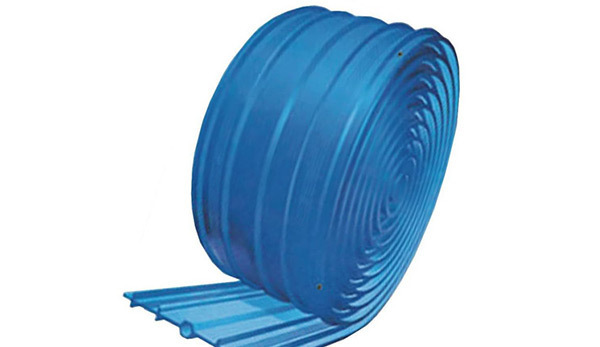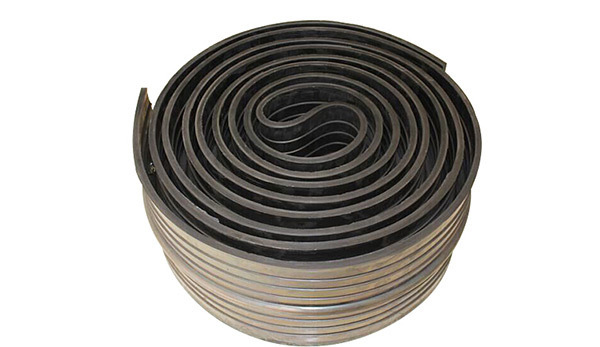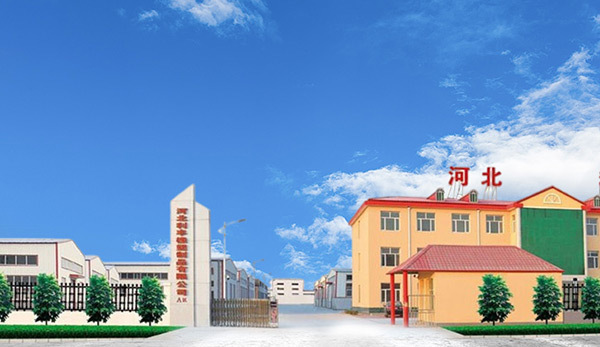The steel edge rubber water stop (also known as: steel edge water stop) is a rubber water stop with a non-uniform thickness structure in its cross-section. The steel edge water stop is divided into a strong area and a waterproof area. Installation holes are added to the steel plate of the water stop and connected to the rebar, making it difficult to displace after being fixed, ensuring that the stress on each part is uniform and reasonable. It has characteristics such as high strength, good elasticity, easy fixation (can be welded to the rebar for fixation), and strong bonding with concrete. However, it has a small elongation rate and poor resistance to bending deformation, making it unsuitable for areas with frequent changes in joint width.
The steel edge rubber water stop (also known as: steel edge water stop) is a rubber water stop with a non-uniform thickness structure in its cross-section. The steel edge water stop is divided into a strong area and a waterproof area. Installation holes are added to the steel plate of the water stop and connected to the rebar, making it difficult to displace after being fixed, ensuring that the stress on each part is uniform and reasonable. It has characteristics such as high strength, good elasticity, easy fixation (can be welded to the rebar for fixation), and strong bonding with concrete. However, it has a small elongation rate and poor resistance to bending deformation, making it unsuitable for areas with frequent changes in joint width.
The back-adhesive rubber water stop is a water-stopping structure set on the outside of the concrete deformation joints and settlement joints of underground structures (water-facing surface).
Good wear resistance and aging resistance: It can maintain stable performance even after long-term use.
High elasticity: Able to adapt to the expansion and contraction of concrete, ensuring water stop effect.
The back-adhesive rubber water stop is a water stop structure set on the outside of the concrete deformation joints and settlement joints of underground structures (water-facing surface).
The water-swelling sealing ring (sheet) is a new product recommended by our company after repeated experiments for the concrete formwork tie bolt project. The water-swelling rubber sealing ring for tie bolts is a new type of waterproof engineering material. It can absorb water and expand upon contact with water, sealing the gaps between the concrete and the tie bolts through its own expansion, effectively preventing water leakage. In actual construction, it is flexible and convenient to operate, saving labor and time. It is an upgraded product of welded sealing plates (rings). Currently, the concrete formwork tie bolt sealing ring has been applied in various projects. The water-swelling sealing ring is made of water-swelling rubber, and its performance meets the indicators specified in GB/T18173-2002 "Polymeric Waterproof Materials" Part 3: Water-Swelling Rubber. When in use, simply fit the sealing ring tightly onto the tie bolt or the bar-type tie rod.
Two-component polysulfide sealant is made of liquid polysulfide rubber as the main material, combined with tackifying resin, curing agents, accelerators, reinforcing agents, and other components to create the sealant. This type of sealant has excellent resistance to fuel, hydraulic oil, water, and various chemicals, as well as heat resistance and atmospheric aging resistance. Generally, it is a curable type. It can be divided into two-component (or three-component) and single-component types based on components. Its processing uses a pre-mixing - grinding - filling method. Two-component polysulfide sealant is a leading waterproof material both internationally and domestically. In developed countries abroad, mid-rise buildings use polysulfide construction paste for wall joint sealing. Polysulfide waterproof sealant is suitable for long-term submerged building joint sealing, with good adhesion to concrete, such as: underground waterproof joints, aircraft runways, water storage tanks, sewage pools, underground projects, and large-scale water conservancy projects all use polysulfide sealant. It has aging resistance, durability, air tightness, and waterproofing properties, with good adhesion and high elongation rubber shape high elasticity. Domestically, this product has been used in some large reservoirs, water storage tanks, sewage pools, and underground projects, receiving high praise from engineering technicians.
The new type of water-swelling sealing strip with mesh is a new waterproof sealing material developed and produced by our company to address the shortcomings of ordinary sealing strips with low tensile strength.
Our company combines engineering practice, and after repeated research experiments and extensive engineering applications, has recently launched a water-swelling waterproof strip for grouting pipes. This product transforms the concept of grouting remediation into reality based on the waterproof principle of the swelling strip. Compared to previous products, this product has advantages such as easy installation, reasonable Price, and better waterproofing effect. Especially with the installation of pre-reserved grouting pipes as a remedial measure, in case of leakage at the seams, there is no need to groove or drill holes on the structural surface for sealing; the grouting liquid can be directly injected into the grouting pipe using the water strip, quickly and conveniently sealing the leakage. Particularly, the application of chemical grouting materials, after selection and adjustment, can cure and solidify in both dry and wet conditions of concrete structures, resulting in a solidified body with excellent mechanical properties and impermeability that meet the requirements for crack reinforcement. This has solved a series of engineering technical problems in the leakage repair operations of concrete projects, demonstrating unique effectiveness and achieving significant social and economic benefits.
The embedded rubber water stop is a product mainly used for setting water stops within concrete deformation joints, expansion joints, etc. It has the ability to adapt to the expansion and contraction of concrete through the elasticity of rubber materials and structural forms. This product utilizes the high elasticity and compressive deformability of rubber to produce elastic deformation under various loads, effectively preventing leakage and seepage of building components, while also providing shock absorption and buffering effects, ensuring the service life of engineering structures.
The embedded rubber water stop is a product mainly used for setting water stops within concrete deformation joints, expansion joints, etc. It has the ability to adapt to the expansion and contraction of concrete through the elasticity of rubber materials and structural forms. This product utilizes the high elasticity and compressive deformability of rubber to produce elastic deformation under various loads, effectively preventing leakage and seepage of building components, while also providing shock absorption and buffering effects, ensuring the service life of engineering structures.
The composite rubber water stop belt is a product made by combining the rubber water stop belt and the water-swelling water stop strip, giving it the dual water stop effect of both the rubber water stop belt and the water stop strip, making the water stop effect safer and more reliable.
Rubber water stop is made using the high elasticity and good compressive deformation of rubber, as well as its high tear strength and tensile strength, to produce elastic deformation under various loads without tearing or breaking, thus serving the purpose of securing seals, preventing seepage, and preventing leaks.
The anti-salt water stop rubber strip is a waterproof material used in construction, engineering, and other fields, mainly used to prevent the penetration of moisture, salt, etc., ensuring the durability and waterproof performance of the structure.
Two-component polysulfide sealant is made of liquid polysulfide rubber as the main material, combined with tackifying resin, curing agents, accelerators, reinforcing agents, and other components to create the sealant. This type of sealant has excellent resistance to fuel, hydraulic oil, water, and various chemicals, as well as heat resistance and atmospheric aging resistance. Generally, it is a curable type. It can be divided into two-component (or three-component) and single-component types based on components. Its processing uses a pre-mixing - grinding - filling method. Two-component polysulfide sealant is a leading waterproof material both internationally and domestically. In developed countries abroad, mid-rise buildings use polysulfide construction paste for wall joint sealing. Polysulfide waterproof sealant is suitable for long-term submerged building joint sealing, with good adhesion to concrete, such as: underground waterproof joints, aircraft runways, water storage tanks, sewage pools, underground projects, and large-scale water conservancy projects all use polysulfide sealant. It has aging resistance, durability, air tightness, and waterproofing properties, with good adhesion and high elongation rubber shape high elasticity. Domestically, this product has been used in some large reservoirs, water storage tanks, sewage pools, and underground projects, receiving high praise from engineering technicians.
The water-swelling sealing ring (sheet) is a new product recommended by our company after repeated experiments for the concrete formwork tie bolt project. The water-swelling rubber sealing ring for tie bolts is a new type of waterproof engineering material. It can absorb water and expand upon contact with water, sealing the gaps between the concrete and the tie bolts through its own expansion, effectively preventing water leakage. In actual construction, it is flexible and convenient to operate, saving labor and time. It is an upgraded product of welded sealing plates (rings). Currently, the concrete formwork tie bolt sealing ring has been applied in various projects. The water-swelling sealing ring is made of water-swelling rubber, and its performance meets the indicators specified in GB/T18173-2002 "Polymeric Waterproof Materials" Part 3: Water-Swelling Rubber. When in use, simply fit the sealing ring tightly onto the tie bolt or the bar-type tie rod.
The water-swelling waterproof strip is widely used in deformation joints, construction joints, waterproof sealing of penetrating pipelines in civil engineering structures, joints of reinforced concrete in shield tunneling, waterproof sealing gaskets, interface materials for pipe jacking projects, sealing of interface for underground pipelines in open-cut box culverts, and waterproof sealing in hydraulic and hydropower engineering, as well as in waterway civil engineering.
In addition to having excellent water stop performance, the outstanding characteristics of PVC water stop belt include its good corrosion resistance and acid-base resistance.
The main performance indicators of the water-swelling water stop strip produced by our company have been tested and qualified by the National Building Materials Testing Center and the Beijing Building Materials Science Research and Testing Institute, and have reached the performance of similar foreign products. This product is a chemical building waterproof material made from more than a dozen materials, including high-grade water-absorbing materials and rubber, mainly aimed at solving the problem of water leakage in construction joints of underground concrete.















